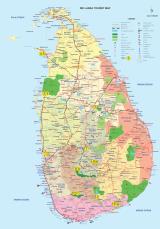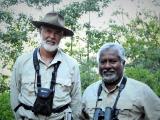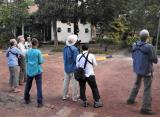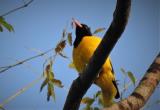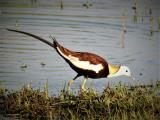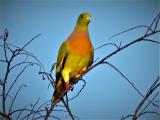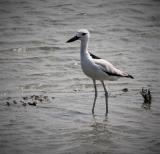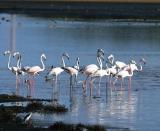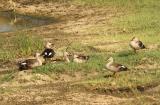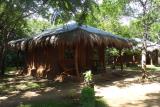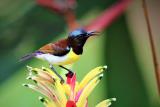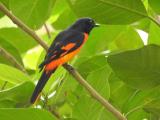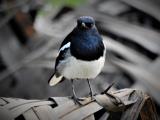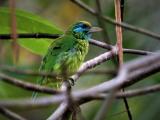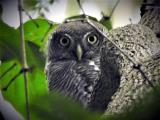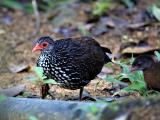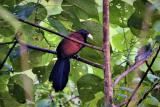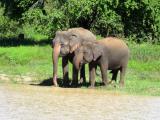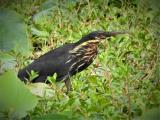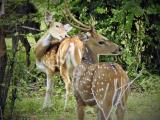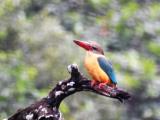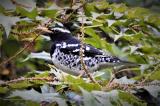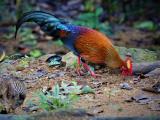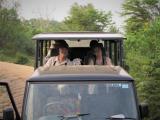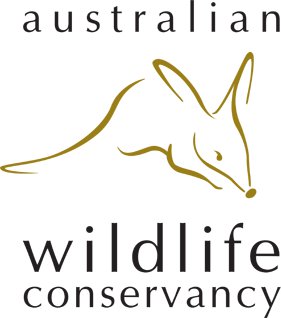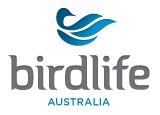Experience Wild Sri Lanka
Sixteen day's birding around Sri Lanka
-
Eighteen day tour, eighteen night tour (16 days birding) that covers the very best of Sri Lanka, with opportunities to see most of the bird species on this island paradise. Experience the Wild is delighted to partner with Sri Lankan private company 'Starron Tours' and offer you a wonderful wildlife experience in Sri Lanka. Learn more about Sri Lanka here. Upali Ekanayake and Mike Jarvis are your guides. Please see guide bios here.
- Key species - Sri Lanka has 33 endemic species which are often the key target species for serious bird watchers. There are a further 53 species that are endemic to India and Sri Lanka, and some of these are easier to see in Sri Lanka than India. Mammals, reptiles and invertebrates also feature on our targets list.
- Will this tour suit me? All accommodation is in comfortable air-conditioned rooms with ensuites. Where possible we spend two nights at the one location and thoroughly explore the area so that we maximise our opportunties to see our target species at a reasonably relaxed pace. Flights to Sri Lanka from Australia are usually quite reasonably priced. Fly either direct from Melbourne or via Singapore or Kuala Lumpur from other Australian cities. Click here for travel tips to Sri Lanka. Click here to see the 'Experience Wild Sri Lanka 2018 Trip Report'
Guests from the 2018 tour, Lindsay and Keith Fisher, have shared their trip report here. - Cost - $5995 per person twin share (single supplement $1275).
- 2021 dates - Sadly this tour is on hold until further notice due to the Covid-19 pandemic
- Book this tour - The 2020 tour has just finished and we will make the 2021 tour available as soon as pricing is confirmed.
Itinerary
Experience Wild Sri Lanka 18 day birding tour – February 1-18, 2020
Day 1 ARRIVAL Saturday 1/02/2020 - Airport TransferArrive at Bandaranaike International Airport and transfer to your hotel at Katunayake. Meet your guides, Upali Ekanayake and Mike Jarvis.
Dinner and overnight stay at Tamarind Tree Hotel. www.tamarindtreehotels.com
Day 2 Sunday 02/02/2020 KATUNAYAKE to SINHARAGAMA. (Distance covered 166 km, est. driving time 4hrs.)
Early morning birding around the hotel grounds before breakfast.
Bird species we are likely to see almost everywhere, everyday, include House Crow, Large-billed Crow, Spotted Dove, Indian Pond Heron, Eastern Cattle Egret, Brahminy Kite, Rock Pigeon, Rose-ringed Parakeet, White-throated Kingfisher, Black-hooded Oriole, Red-vented Bulbul, Yellow-billed Babbler, Oriental Magpie-robin and House Sparrow.
After breakfast we travel north along the coast, making several birding stops along the way as we pass through Chilaw, Anaivilundawa Ramsar Wetland, Mundel Lagoon, Navadankulama Tank and Puttalam Lagoon.
We spend the afternoon birding around the gardens at Hotel Sinharagama Resort and Spa.
Some of our target species today are: Brown-headed Barbet, Pheasant-tailed Jacana, Black-hooded Oriole and Red-backed Woodpecker
Each night over dinner we review the days sightings using your complimentary Checklist Journal and preview the next days locations and targets.
Dinner and accommodation at Hotel Sinharagama Resort.
Day 3 Monday 03/02/2020 Explore WILPATTU NATIONAL PARK (Distant to the Park Entrance is about 20 km., est. driving time about 20 min, plus the jeep drive...)
A very early start carrying picnic breakfast and lunch to do a full day safari in jeeps in the Wilpattu National Park which is famous for birds and other wildlife including the Sri Lanka Leopard.
Target species:- Indian Peafowl, Sri Lanka Junglefowl, Crested Serpent Eagle, Changeable Hawk-Eagle, Orange-breasted Green Pigeon, Green Bee-eater, Sri Lanka Leopard, Sloth Bear
Dinner and accommodation at Hotel Sinharagama Resort.Day 4 Tuesday 04/02/2020 SINHARAGAMA to MANNAR. (Distance from the Park Entrance is about 143 km., est. driving time about 2 hr, 45 min.)
We make several birding stops along the way as we pass through a number of wetlands around Thanthirimale, Cheddikulam, the amazing historic Giant’s Tank Sanctuary, Vankalai Ramsar Wetland and two small Thallady Ponds.
Target species today:- Western Reef Egret, Black Kite, White-bellied Sea Eagle, Indian Thick-knee, Great Thick-knee, Crab Plover, Yellow-wattled Lapwing, Pacific Golden Plover, Grey Plover, Common Ringed Plover, Little Ringed Plover, Kentish Plover, Greater Painted Snipe, Pheasant-tailed Jacana.
Dinner and accommodation at The Palmyrah House, Mannar.
Day 5 Wednesday 05/02/2020 Explore MANNAR
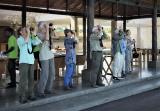
After exploring the grounds at Palmyrah House, where we are likely to see Eurasian Hoopoe, Grey Francolin and Black Drongo, we enjoy breakfast then spend the morning exploring the Uramalai and Adam’s Bridge area. This area teams with waders, terns and gulls. In the afternoon we explore the Poonaryn Road area.
Our target species today are:-
Grey Francolin, Eurasian Wigeon, Spot-billed Duck, Northern Shoveler, Northern Pintail, Garganey, Common Teal, Cotton Pygmy Goose, Greater Flamingo, Striated Heron, Pintail Snipe, Common Snipe, Eurasian Curlew, Spotted Redshank, Common Redshank, Green Sandpiper, Wood Sandpiper, Terek Sandpiper, Temminck's Stint, Long-toed Stint, Curlew Sandpiper, Broad-billed Sandpiper, Eurasian Hoopoe, Long-tailed Shrike, Black Drongo, Lesser Whitethroat, Hume's Whitethroat.
Dinner and accommodation at Palmyrah House, Mannar Island.
Day 6 Thursday 06/02/2020 MANNAR to HABARANA (Distance covered 180 km, est. driving 3hr., 30min)
Breakfast at the hotel. We search good birding locations around Mannar and then travel to Habarana via Medawachchiya and Anuradhapura.
Our target species today are Eurasian Collared Dove, Indian Roller, Jerdon's Nightjar, Indian Pitta, Orange-headed Thrush, Cotton Pygmy Goose, Little Grebe, Little Cormorant, Indian Cormorant, White-bellied Sea-eagle, Malabar Pied Hornbill, Stork-billed Kingfisher, Common Kingfisher, Brown-capped Pygmy Woodpecker, Indian Robin, Purple-rumped Flowerpecker, Thick-billed Flowerpecker
Dinner and accommodation at The Other Corner, Habarana.
Day 7 Friday 07/02/2020 HABARANA to KANDY (Distance covered 96 km, est. driving 2hr, 20min.)
After breakfast at the The Other Corner, we proceed to Sigiriya Sanctuary area for a short birding session. We continue on to Kandy where we check in to the Hotel Suisse, then visit the historic Peradeniya Royal Botanic Garden in the afternoon. Kandy is also a great place for souvenir shopping if there is time.
Our target species today in Sigariya are Shaheen Falcon, Shikra, Sri Lanka Green Pigeon, Alexandrine Parakeet, Indian Cuckoo, Drongo Cuckoo, Blue-faced Malkoha, Crested Treeswift, Malabar Pied Hornbill, Crimson-fronted Barbet, Rufous Woodpecker, Lesser Sri Lanka Flameback, Common Woodshrike, Large Cuckoo-Shrike, Blackheaded Cuckoo-Shrike, Small Minivet, Bar-winged Flycatcher-Shrike, Greater Racket-tailed Drongo, Brown-capped Babbler, Tawny-bellied Babbler, Dark-fronted Babbler.
Target species in Peradeniya Royal Botanic Garden are Sri Lanka Hanging Parrot, Alexandrine Parakeet, Layard’s Parakeet, Common Hawk Cuckoo, Banded Bay Cuckoo, Crimson-fronted Barbet, Indian Pitta and Southern Hill Myna.
Dinner and accommodation at the Thilaka Hotel, Kandy.
Day 8 Saturday 08/02/2020 KANDY to KITULGALA. (Distance covered 64 km, est. driving time 2 hrs.)
After breakfast we visit the Royal Forest Park, Udawattakele. Continue on to Kitulgala, bird around the gardens at Kitulgala Rest House
Udawattakele Sanctuary: Brown Fish Owl, Sri Lanka Hanging Parrot, Alexandrine Parakeet, Layard’s Parakeet, Oriental Dwarf Kingfisher, Yellow-fronted Barbet, Crimson-fronted Barbet, Lesser Yellownape, Lesser Sri Lanka Flameback, Sri Lanka Greater Flameback, Brown-capped Babbler, Velvet-fronted Nuthatch, Southern Hill Myna, Indian Blue Robin, White-rumped Shama and Tickell's Blue Flycatcher.
Dinner and accommodation at Kitulgala Rest House.
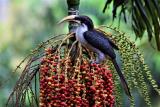
Day 9 Sunday 09/02/2020 KITULGALA.
Explore Kitulgala village area. The Kelani River runs through the thickly forested area and is a magnet for white water rafting thrill-seekers. It is also the location for the filming of 'The Bridge on the River Kwai' filmed in 1957.

Target species: Sri Lanka Grey Hornbill, Sri Lanka Hanging Parrot, Oriental Dwarf Kingfisher, Black-capped Bulbul, Chestnut-backed Owlet, Stork-billed Kingfisher
Dinner and accommodation at Kitulgala Rest House.
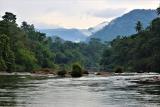
Day 10 Moday 10/02/2019 KITULGALA to SINHARAJA (Distance covered 114 km, est. driving time 3hr, 10min.)
After birding around the Kitulgala Rest House grounds and breakfast, we check out and head up to the dense Sinharaja rainforest.
After checking in at the Blue Magpie Lodge we bird around the Lodge where the tall trees and fruit tables attract many of the species we have come here to see.
Target species: Black Bulbul, Asian Paradise Flycatcher, Plum-headed Parakeet, Sri Lanka Hanging Parrot
Dinner and accommodation at The Blue Magpie Lodge.
Day 11 Tuesday 11/02/2020 EXPLORE SINHARAJA (Jeep trip and trek in Sinharaja Forest)
Early breakfast at the lodge and then jeep trip to Sinharaja Forest. Walk the jungle trail, watching and listening for ‘bird waves’ – mixed species feeding flocks. Look out for the unique Sinharaja Pitcher Plant Nepenthes distillatoria .
Our target species today are:- Sri Lanka Blue Magpie, Red-faced Malkoha, White-faced Starling,
Dinner and accommodation at The Blue Magpie Lodge.
Day 12 Wednesday 12/02/2020 SINHARAJA to UDAWALAWE (Distance covered 85 km, est. driving time 2hr, 25min.)
Early departure in jeeps to Spurfowl House, cut breakfast. We travel in jeeps along the steep up and down and windy tacks through villages, tea plantations and jungle to a house where we are welcomed as guests. Here the family invite us into there dining room where we look straight out the window to the small garden on the edge of the jungle. Spurfowl, Sri Lanka Junglefowl and Slatey-legged Crake and Ruddy-breasted Crake often appear out of the jungle and come to the garden for scraps and to drink. Other species that may be seen here are Green-billed Coucal, Red-faced Malkoha, Blue Magpie and Red-backed Woodpecker.
Our target species today are:- Sri Lanka Blue Magpie, Red-faced Malkoha, Sri Lanka Spurfowl, Sri Lanka Junglefowl,
Back to the lodge for 10am check out.Continue on to Udawalawe.
Dinner and accommodation at Centauria Wild.
Day 13 Thursday 13/02/2020 UDAWALAWE to TISSAMAHARAMA (Distance covered 57 km, est. driving time 1hr, 5min.)Early morning jeep trip at Udawalawe National Park. This park is outstanding for it's elephants. Other mammals such as Golden Jackal, Spotted Deer and Grey Mongoose can be seen here and the birdlife is quite varied. Our jeep drivers are know the habitat very well and are alert to new species, often spotting them before the guides.
Explore Tissamaharama wetlands. We meet up with some young lads who are very observant of local birdlife and lead us to some owl day roosts.
Target species today:- Jungle Owlet, Brown Fish Owl, Indian Scops Owl, Barred Button-quail, Asian Elephant, Golden Jackal, Spotted Deer, Mugger Crocodile
Dinner and accommodation at The Rain Tree Hotel Tissamaharama.
Day 14 Friday 14/02/2020 Explore LUNUGAMVEHERA NATIONAL PARK
In the morning we explore Lunugamvehera (Veheragala) National Park. The jeep trip offers more opportunities to see Elephants, Leopards, Deer and other mammals. The list of birds recorded in the park is 183 species.
After lunch we explore Tissa wetlands.
Our target species today are:- Black Bittern, Yellow Bittern, Watercock, Spoonbill, Spot-billed Pelican, Little Grebe
Dinner and accommodation at The Rain Tree Hotel, Tissamaharama.
Day 15: Saturday 15/02/2020 TISSAMAHARAMA to NUWARA ELIYA (Distance covered 146 km, est. driving time 3hr, 50min.)
Jeep trip to Bundala National Park where we find an exceptional number and variety of waders, terns and other waterbirds.
Continue on to Nuwara Eliya which at 1868m is one of the highest towns in Sri Lanka and has a history as a hill country retreat, called 'little England' in colonial days. It is a great birding destination, with the gardens at Victoria Park attracting many endemic species and likewise with the nearby Hakgala Botanical Gardens.
We check in at the Heaven Seven Hotel and then go birding at Victoria Park.
Target species:- Pied Thrush, Kashmir Flycatcher, Sri Lanka White-eye, Indian Pitta, Forest Wagtail, Grey Wagtail, Yellow-fronted Barbet, Sri lanka Greater Flameback, Asian Great Tit,
Dinner and accommodation at Heaven Seven Hotel, Nuwara Eliya.
Day 16 Sunday 16/02/2020 Explore NUWARA ELIYA.

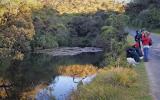
A predawn start carrying picnic breakfast to reach Horton Plains National Park at first light. We spend the morning exploring Horton Plains National Park looking for the highland endemics. At an elevation of 2,500 metres, we are dressed for cold weather.
In the afternoon we go back to Nuwara Eliya and from there we explore Hakgala Botanical Gardens. This is a great location for Sri Lanka Scimitar Babbler and Chestnut-backed Owlet.
Our target species today are Sri Lanka Junglefowl, Jerdon's Baza, Himalayan Buzzard, Black Eagle, Rufous-bellied Eagle, Legge’s Hawk-Eagle, Sri Lanka Woodpigeon, Hill Swallow, Yellow-eared Bulbul, Sri Lanka Bush Warbler, Sri Lanka Scimitar Babbler, Sri Lanka White-eye, Velvet-fronted Nuthatch, Sri Lanka Whistling Thrush, Pied Thrush, Indian Blackbird, Indian Blue Robin, Pied Bushchat, Kashmir Flycatcher, Dusky-blue Flycatcher, Grey-headed Canary Flycatcher, Black-throated Munia.
Dinner and accommodation at Heaven Seven Hotel, Nuwara Eliya.

Day 17 Monday 17/02/2019 NUWARA ELIYA to KATUNAYAKE. (Distance covered 177 km, est. driving time 4hr, 45min.
We depart Nuwara Eliya for Katunayake via Gampola, Peradeniya and Kandy. We may have a short stop in Kandy for some souvenir shopping and lunch, or visit a tea factory. Then we proceed through Mawanella, Kegalle, Nittambuwa and Minuwangoda, to Katunayake.
Final dinner together and accommodation at Tamarind Tree Resort.
Day 18 - Tuesday 18/02/2019
After a group breakfast at The Tamarind Tree Hotel we say our goodbyes, some may stay another day or two in Sri Lanka, others will be heading home.
The Tamarind Tree Hotel provides transfers to Bandaranaike International Airport at a very modest charge.
Please Note: The above itinerary is based on the outcomes of many previous tours to the areas described. Each season is different and as various wildlife observing opportunities arise and depending on the preferences of the group, adjustments will be made.
Inclusions - Accommodation double/twin sharing in standard rooms, travel in air-conditioned vehicle with an experienced English speaking chauffeur, local ornithologist and EtW guide, entrance fees to all sites and national parks mentioned and jeep hire, breakfast and dinners each day including group breakfast on day 18, bottled water available at all times. Forty page booklet - combined checklist, itinerary, map and journal. Tips are customarily paid to local guides, jeep drivers, chauffeurs and hotel staff, this is a hidden cost and is completely covered on your behalf by Experience the Wild.
Exclusions - Pre and post tour accommodation, flights to and from Sri Lanka, airport tax, travel insurance, visa fees, items of a personal nature such as drinks, laundry, etc. lunches thoughout the tour entry fees for sites mentioned other than included, early check-in and late check out.
Group Tour - $5995 per person twin share, single supplement $1275.
Click Here to Check Availability and Book Now!
All prices are in Australian dollars. Please click here for conversion to your currency.
Booking Procedure - You can book directly using our secure online booking site by clicking here. Payment options are Visa, Mastercard, Paypal or Bank Transfer. A 20% deposit secures the booking, the balance is due 30 days prior to start of tour. Please feel free to contact us if you have any queries regarding the tour.
Further Information - Please click here for our Terms and Conditions document. Click here to download our 'What to expect on an Experience the Wild tour' document. Email enquiries@experiencethewild.com.au or ring Jenny or Mike on 0400 404 058
Important information on visiting Sri Lanka - Please read Sri Lanka Travel Tips
Birdwatching Ethics
Most birdwatchers are cognizant of the needs of birds and avoid causing any undue stress to their avian subjects. We don't use playback to bring birds closer and we keep a respectable distance from nests. There are photos of birds at the nest on this website. These are taken from a reasonable distance with aid of powerful zoom lenses and in most cases, from an established pathway. Also, we don't chase or deliberately flush birds. Quietly stalking them will yield better results, but even this can be interpreted by birds as predatory behaviour. The most satisfying close encounters are had when birds move in to range of their own volition when we wait patiently in the one location. We never place food to bait birds to come in to range. Guides have the benefit of an intimate familiarity with local species and habitats and can set you up to get great results without resorting to questionable practises. Guests are encouraged to speak up if they see any situation that could be detrimental to birds or habitat while on tour.

